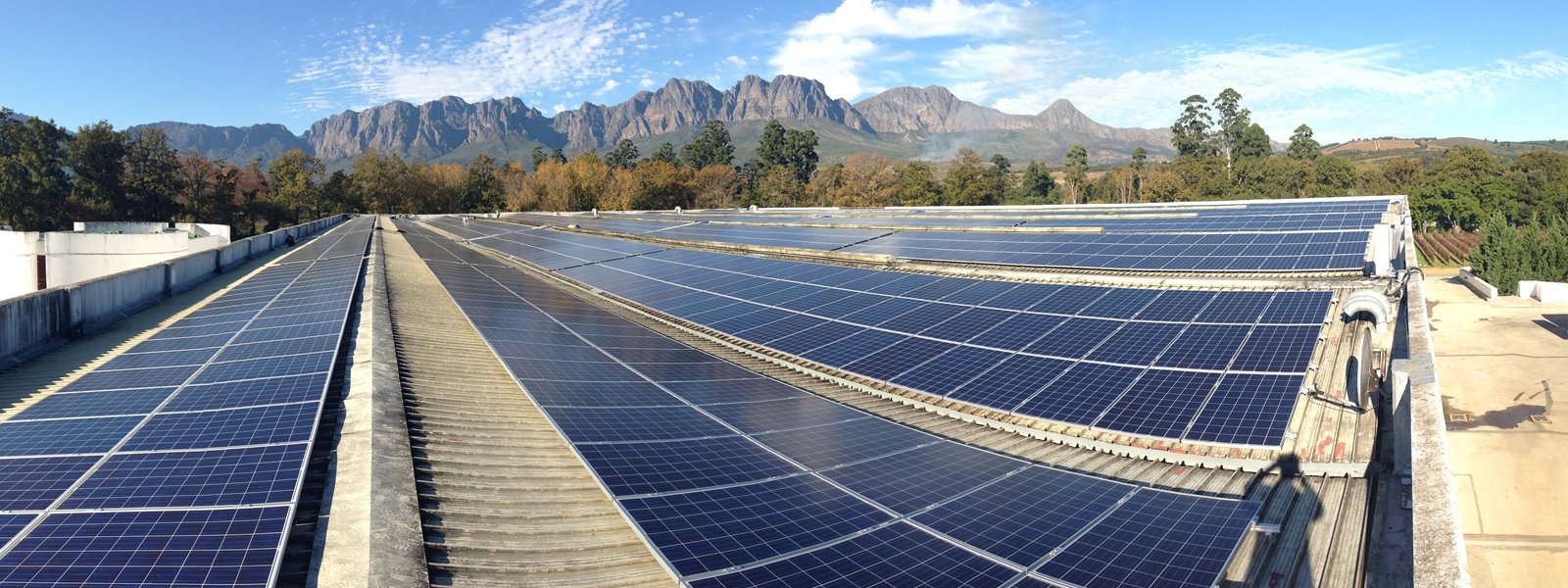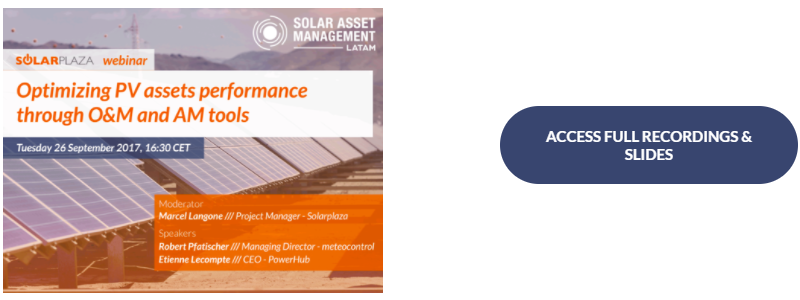
On the 26th of September 2018, Solarplaza organized a webinar on the topic of improving the development of solar PV assets: “Optimizing PV assets performance through O&M and AM tools”. It was hosted in the run-up to the 2-day Solar Asset Management Latin America (SAM LATAM) conference organized in Santiago de Chile on the 17th and 18th of October, 2017. Marcel Langone, project manager at Solarplaza, was joined by Robert Pfatischer, managing director at Meteocontrol, and Etienne Lecompte, CEO at PowerHub, to give an in-depth look at the different uses of operations & management and asset management tools. The entire video recording of the webinar and the speakers’ slides can be freely accessed here. (insert hyperlink)
Robert Pfatischer, managing director at Meteocontrol with 15 years of experience at the company, sees monitoring tools as an important requirement when it comes to managing plants. He further explains that there are key differences in monitoring solar projects of different scales.
Monitoring
For small commercial rooftops, the starting point is the data logging, which can be integrated in a data station or housing. It is recommended to use a solar irradiance sensor next to the solar panels to precisely measure the amount of solar energy hitting the rooftop. The next tool would be the monitoring system used to evaluate the performance and handle any alarms regarding the solar project. The final tool is the use of satellite data as an independent data source for on-site measurements as a fall back solution when it comes to evaluation of the performance.
For commercial rooftops or PMGD projects up to 9 MW, requirements include a professional yield report, construction supervision and technical acceptance. It is interesting to note that an environmental impact declaration is not necessary for projects up to 3 MW. For projects up to 9MW, feed-in management and power control are essential. When it comes to the monitoring systems, it does not only evaluate performance and handle alarms, but it also reports the data, which is becoming more and more important.
With utility scale projects, the starting points are similar to the commercial rooftop requirements regarding reports, data logging, supervision, monitoring, etc. One extra element that is included is on-site controlling systems, requiring a local SCADA system with additional sensors and interfaces for PPA offtakers and energy traders who need to get operational data in real time.
The core business of Meteocontrol is remote monitoring and it executes this by analyzing the performance of different portfolios, as well as using a ticket system. The analysis shows a clear overview of red and green colors indicating the levels of performance and displays alerts if any alarms go off. This way no malfunction goes by unnoticed, therefore problems or yield losses can be avoided. The system also analyzes the performance of the inverters in order to identify which inverters are underperforming and why. With this system, investors are able to get a short overview of the key performance indicators, for example, on a dashboard that shows the forecasted yield compared to the actual data.
When installing these kinds of systems in various locations, one has to take into consideration that there are going to be challenges, as well as lessons learned for future projects. One of those lessons was the fact that different system categories have different requirements regarding monitoring and management. Another lesson was that the sooner you instal a monitoring system, the better. Failures of the PV systems can be immediately detected and fixed as soon as the system is in place. A flexible solution for such problems is the combined use of remote and local monitoring for large plants or portfolios. According to Robert, in order to optimize PV assets performance, professional and advanced tools are the basis for monitoring and improving solar energy projects.
Software
Etienne sees that businesses are starting to use software in more diverse ways as a means to optimize their assets. He also believes that software and processes go hand in hand. Therefore, companies can benefit from a better foundation with the use of software. Asset owners can start small and opt to use only certain applications for monitoring or tracking. As assets grow, the owners can decide to include different digitized processes as well.
There are 3 different types of companies that are interested in software. The first type of companies are those types of companies are firms that want to implement softwares before growth. These companies are often active in new markets and are setting up processes for the first time. Most of them want to implement a software before they go on a acquisition spree. This type wants to get all of their assets in order before they have the capabilities to scale up.
The second type involves companies wanting to add software to their value chain during growth. These companies have already refined their processes and have defined how they are going to run their business in order to digitize their processes, digitize their workflows and the automate the time consuming processes.
The last type are companies that are already under water, meaning that they have already grown rapidly while still having to handle a lot of manual processes. These companies need a solution as soon as possible.
According to Etienne, software creates efficiencies and effectiveness within the team. It is all about choosing the right moment to implement the software. However, gradually implementing a system in place could help a company out during those changes. When companies buy software, they are actually buying more than just that. They are buying time, buying resources, reducing risks, enhancing productivity and enhancing transparency. When it comes to Chile, software has helped to facilitate and improve the way invoices are made with regards to PMGDs, settling shadow settlements, managing contracts and issuing reports.
One important thing that is always discussed with a variety of parties when it comes to software is whether or not a company wants to buy or build software. Some parties think that they can build a system in-house from origination till long term operation in order to fully-own the software and apply it to all of their processes. These types of systems work great in the beginning. However, as soon as new and more complex processes are added to the pipeline, systems are not usually flexible enough to accommodate these new processes.
Another thing to take into consideration is the difference between an independent service providers and bundle service providers. Independent service providers are mostly specialized in software, while bundle service providers have a wider variety of softwares and systems that can help to add value to businesses. Independence is key when choosing softwares in order to find a system that can work with multiple different partners or operations providers. Etienne concludes that software should have its place in the ecosystem of companies because, ultimately, it can serve as a tool to improve businesses processes and add value to to the company.

